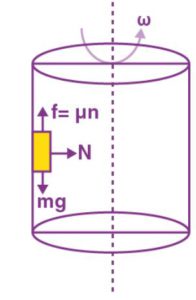
m = 70 kg m
The drum’s radius is 3 metres.
= 0.15 is the coefficient of friction between the wall and his clothes.
The number of revolutions per minute of a hollow cylindrical drum is 200/60 = 10/3 revolutions per second.
The normal N of the wall on the guy provides the needed centripetal force.
mv2/R = m2R N = mv2/R = m2R
The guy adheres to the drum’s wall while the floor spins. As a result, the frictional force acting vertically upwards balances the weight of the man (mg) acting downward.
If mg limits frictional force fe (N), the guy will not fall.
mg ≤ μN
mg ≤ μ (mω2R)
ω2 ≥ g/Rμg
As a result, given the cylinder’s minimum rotational speed,
ω2 = g/Rμ = 10/(0.15 x 3) = 22. 2
ω =√22.2 = 4.7 rad
